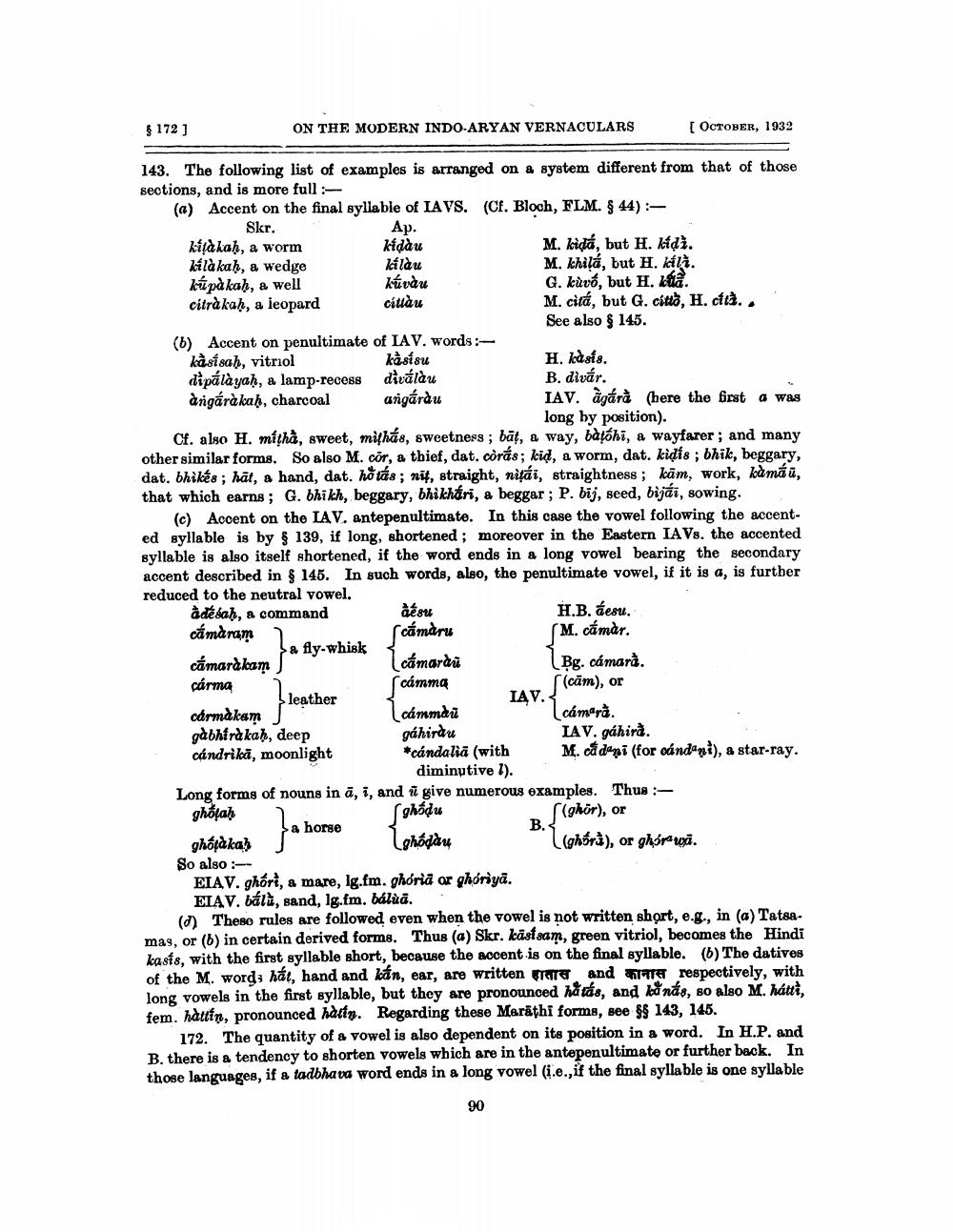________________
$ 172 )
ON THE MODERN INDO-ARYAN VERNACULARS
[OCTOBER, 1932
wing
143. The following list of examples is arranged on a system different from that of those sections, and is more full :(a) Accent on the final syllable of IAVS. (Cf. Bloch, FLM. § 44) :Skr.
Ap. kilkah, a worm
kidau
M. kidá, but H. kidi. loilà kah, a wedge
kalau
M. khilá, but H. Kla. kú på kah, a well
kúvdu
G. kuvó, but H. KUR citràkah, a leopard citàu
M. citá, but G. cótio, H. cità.
See also $ 145. (6) Accent on penultimate of IAV. words: kàsisah, vitriol
käsisu
H. Isis. dipálayah, a lamp-recess diválau
B. divár. árgárakah, charcoal angárdu
IAV. agárd (here the first a was
long by position). Cf. also H. mithà, sweet, mithás, sweetness; bāt, a way, båtóhi, a wayfarer; and many other similar forms. So also M. cor, a thief, dat. córás; kid, a worm, dat. kidís ; bhik, beggary, dat. bhikes : hôt, a hand, dat. hồ tás; nit, straight, nifái, straightness; kām, work, kama u, that which earns; G. bhikh, beggary, bhikhári, a beggar; P. bij, seed, bijái, sowing.
(c) Accent on the LAV. antepenultimate. In this case the vowel following the accented syllable is by § 139, if long, shortened ; moreover in the Eastern IAVs. the accented syllable is also itself shortened, if the word ends in a long vowel bearing the secondary accent described in $ 145. In such words, also, the penultimate vowel, if it is a, is further reduced to the neutral vowel, àdésah, & command
ésu
H.B. áesu. cámaram
Scámaru
M. cámar. La fly-whisk cámardkam
I cámarau
Bg. cámard. cárma
cám ma
(cām), or leather
IAV. carmakam J
(cám màu
cámara. gabhirakah, deep
gáhindu
IAV. gáhird. cándrikā, moonlight *cándalia (with M. cadani (for oándant), a star-ray.
diminutive 1). Long forms of nouns in ā, i, and il give numerous examples. Thus -
ghodu a horse ghốjàka) J
Lghốdary
(ghorà), or ghóra usā. So also :
EIAV. ghori, a mare, lg.fm. ghoria or ghóriya.
EIAV. bálù, sand, 1g.fm. bálùa. -
(d). These rules are followed even when the vowel is not written short, e.g., in (a) Tatsamay, or (b) in certain derived forms. Thus (a) Skr. käsi sam, green vitriol, becomes the Hindi kasts, with the first syllable short, because the accent is on the final syllable. (6) The datives of the M. word; hát, hand and kdn, ear, are written and respectively, with long vowels in the first syllable, but they are pronounced ha rás, and ko nás, so also M. hátt, fem. nautin, pronounced hatin. Regarding these Marathi forms, see $$ 143, 145.
172. The quantity of a vowel is also dependent on its position in a word. In H.P. and B. there is a tendency to shorten vowels which are in the antepenultimate or further back. In those languages, if a tadbhava word ends in a long vowel (i.e., if the final syllable is one syllable
ghățah
2
f(ghör), or
90




